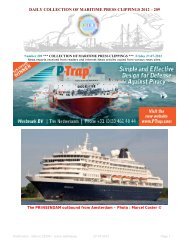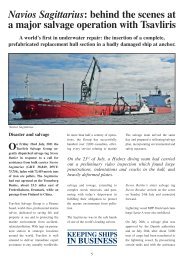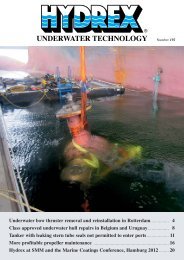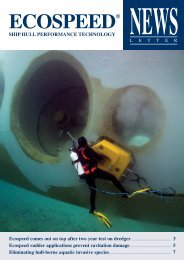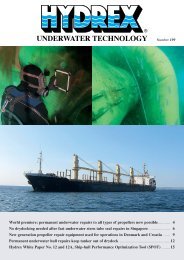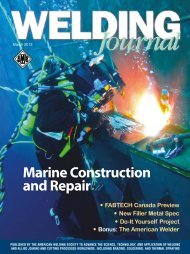Active with jobs around the world Fast and easy Ecospeed ...
Active with jobs around the world Fast and easy Ecospeed ...
Active with jobs around the world Fast and easy Ecospeed ...
Create successful ePaper yourself
Turn your PDF publications into a flip-book with our unique Google optimized e-Paper software.
The high st<strong>and</strong>ard that Hydrex dem<strong>and</strong>s for an <strong>Ecospeed</strong> application does not<br />
mean that learning to work <strong>with</strong> <strong>the</strong> coating is a difficult process.<br />
that absolutely no rain damage was<br />
visible at all. There were also no<br />
signs of ‘solvent-entrapment’ whatsoever,<br />
which sometimes occurs<br />
when solvent based coatings are<br />
applied onto too hot of a surface.<br />
Twenty minutes later <strong>the</strong> hull had<br />
dried up <strong>and</strong> we could continue<br />
spraying again.”<br />
<strong>Ecospeed</strong> only requires two layers<br />
of 500 µm each. This is also a major<br />
advantage compared <strong>with</strong> o<strong>the</strong>r hull<br />
coatings. “Whe<strong>the</strong>r you’re looking at<br />
classic antifouling coating systems<br />
which easily have five or more<br />
coating layers to be applied, or when<br />
comparing <strong>Ecospeed</strong> to some of <strong>the</strong><br />
newer silicone based hull coatings,<br />
which also consist of four to five<br />
layers of coating to be applied, a<br />
two coat application is always going<br />
to be quicker, cheaper <strong>and</strong> more<br />
flexible,” Gunnar Ackx explains.<br />
The coating schedule can be adapted<br />
to that of <strong>the</strong> yard <strong>and</strong> it does not<br />
have to be <strong>the</strong> o<strong>the</strong>r way <strong>around</strong>. A<br />
traditional paint application schedule<br />
is defined by surface preparation <strong>and</strong><br />
by <strong>the</strong> wea<strong>the</strong>r conditions, which are<br />
difficult to predict. In this respect <strong>the</strong><br />
application of <strong>Ecospeed</strong> is easier to<br />
adapt to <strong>the</strong> application windows that<br />
become available. You can apply <strong>the</strong><br />
coating quite rapidly on a prepared<br />
surface <strong>and</strong> <strong>the</strong> possible overcoat<br />
time ranges from three hours to very<br />
extended periods of time. Depending<br />
on whatever suits <strong>the</strong> owners’ or<br />
<strong>the</strong> shipyard’s schedule <strong>the</strong> second<br />
(final) coat can be applied <strong>with</strong>in a<br />
couple of hours or after a few weeks<br />
or even months.<br />
Easier to plan drydockings<br />
for <strong>the</strong> rest of <strong>the</strong> vessel’s<br />
service life<br />
The durability of <strong>Ecospeed</strong> makes<br />
<strong>the</strong> planning of future drydockings<br />
far easier for <strong>the</strong> shipowner <strong>and</strong><br />
<strong>the</strong> shipyard. Shipowners will not<br />
have to do any repainting beyond<br />
17<br />
minor touch-ups, if needed. These<br />
can easily be done during a short<br />
drydock visit, which is in contrast to<br />
<strong>the</strong> full renewal of paint layers that<br />
is needed <strong>with</strong> o<strong>the</strong>r paint systems.<br />
<strong>Ecospeed</strong> is a coating system that<br />
lasts <strong>the</strong> lifetime of <strong>the</strong> vessel; <strong>the</strong><br />
initial application is <strong>the</strong>refore critical<br />
for <strong>the</strong> success of <strong>the</strong> coating.<br />
Mr. Ackx confirms that if a ship<br />
coated <strong>with</strong> <strong>Ecospeed</strong> comes into<br />
drydock after some years of service,<br />
<strong>the</strong> planning of this docking is so<br />
much simpler than <strong>with</strong> vessels<br />
coated <strong>with</strong> o<strong>the</strong>r underwater hull<br />
paint systems. “I have had <strong>the</strong> op-<br />
portunity of witnessing <strong>the</strong> drydocking<br />
of a number of vessels, <strong>with</strong><br />
different types of hull coatings. With<br />
classic antifoulings, most people in<br />
<strong>the</strong> shipping industry know what’s<br />
happening: <strong>the</strong> antifouling has to be<br />
renewed every three to five years,<br />
maximum, during which <strong>the</strong>re will<br />
also easily be five, ten or more<br />
percent of corrosion present on <strong>the</strong><br />
underwater hull, which requires spot<br />
blasting <strong>and</strong> touch-up as well. After<br />
a couple of recoating cycles, <strong>the</strong><br />
total coating system becomes<br />
increasingly weaker, resulting in<br />
more repairs <strong>and</strong> maintenance<br />
that needs to be done <strong>with</strong> every<br />
drydocking <strong>and</strong> this up to <strong>the</strong> point<br />
where <strong>the</strong> entire underwater hull<br />
needs to be fully reblasted.”<br />
Mr. Ackx says that <strong>the</strong> newer<br />
hull coatings such as silicone<br />
based coatings provide for better<br />
performance in that department,<br />
but also come <strong>with</strong> a higher initial<br />
installation cost. “Having seen a<br />
silicone based antifouling on a ship<br />
that was drydocked after some three<br />
years of service, I must admit that<br />
<strong>the</strong> hull looked very good <strong>and</strong> could<br />
be cleaned quite easily. The problem<br />
is that such a coating is soft <strong>and</strong> has<br />
relatively limited thickness. Hence



